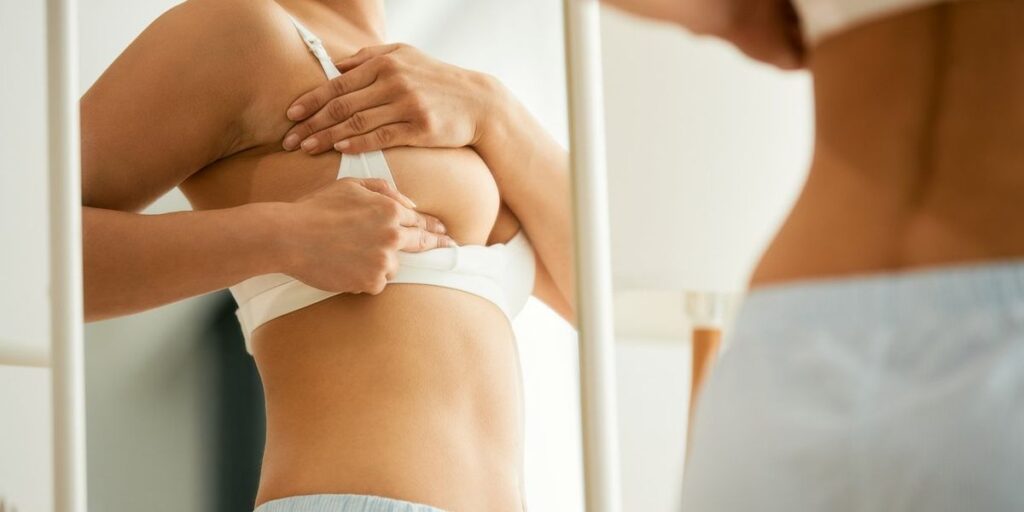“Breast self-exams are now not beneficial.”
Once I noticed that headline earlier this 12 months, I believed it was a typo. As somebody who discovered my very own breast most cancers lump that turned out to be stage 3 cancer, I used to be stunned to be taught that many well being organizations just like the American Most cancers Society and Nationwide Most cancers Institute don’t advocate breast self-exams. They usually haven’t for years.
So what occurred?
The breast self-exam was created within the Fifties as a handy and low-cost manner for individuals to catch breast most cancers early, when it’s most treatable. However within the 2000s, research discovered that doing formal breast self-exams (elevating your arms, mendacity down, round motions, and many others.) might not scale back your threat of dying from breast most cancers. One meta-analysis evaluating girls who did routine breast self-exams to those that didn’t do self-exams discovered that there was no distinction of their breast most cancers survival charges. However individuals who carried out self-exams had extra false positives and almost twice as many breast biopsies with no most cancers.
Read: What You Need to Know About a Breast Biopsy >>
With out knowledge to indicate that breast self-exams can lower the chance of dying from breast most cancers — and the opportunity of hurt from pointless testing — breast self-exams are now not beneficial for individuals of common threat by {most professional} organizations and healthcare suppliers. (Common threat means you haven’t any private or household historical past or genetic mutation, like BRCA 1 or BRCA 2)
Larry Norton, M.D., a breast medical oncologist at Sloan Kettering Most cancers Heart, mentioned the rule of thumb shift away from formal breast self-exams doesn’t imply it’s best to cease taking note of your breasts. It’s referred to as breast self-awareness.
What’s breast self-awareness?
Breast self-awareness is being acquainted with how your breasts feel and look so you possibly can establish any modifications. “The lack of understanding of what is wholesome in your physique can inhibit you from figuring out one thing that is not fairly proper,” Norton mentioned. “It is excellent to know there’s one thing totally different in your physique, and it is excellent whenever you discover one thing totally different — it doesn’t matter what that’s — to name consideration to it.”
Not like breast self-exams, there’s no timeline or method to breast self-awareness — it’s principally utilizing your eyes and arms to know what’s regular for you. Indicators of breast most cancers to search for can embrace:
- Lumps
- Ache
- Dimples within the pores and skin
- Discharge or bleeding from the nipple
- Redness or heat
- Swelling/modifications in dimension
Norton mentioned modifications in look and nipple discharge are extra apparent, however understanding how your breasts really feel is essential since you could possibly choose up on indicators of breast most cancers that your supplier or imaging didn’t catch. “Once you contact your breast, and you are feeling an uncommon laborious place or an uncommon place that hurts however didn’t damage earlier than — these are the issues which are just a little bit extra delicate,” Norton mentioned.
Breast self-exam timing and dangers
Though most healthcare suppliers advocate breast self-awareness over formal breast self-exams, some individuals should need to follow the usual method and routine. When you do breast self-exams, it’s finest to do them three to 5 days after your interval ends, when your breasts are much less delicate or lumpy. When you’re postmenopausal, do the self-exam on the identical time every month.
Read: How to Do a Breast Self-Exam >>
The dangers related to formal breast self-exams embrace false positives and pointless biopsies of tissue that’s non-cancerous. Researchers say the psychological and monetary stress of imaging and biopsies can be a part of the reasoning towards formal breast self-exams. Nevertheless, it’s essential to notice that false-positive outcomes are frequent, and the probabilities of getting a false-positive outcome improve as you age. Concern about false positives shouldn’t cease you from taking note of your breast well being and contacting your healthcare supplier in the event you see or really feel something uncommon to you.
Norton mentioned being acquainted with your breasts so as to discover modifications is the takeaway for self-exams. However neither breast self-awareness nor self-exams are a alternative for mammograms in the case of screening for breast most cancers.
When to get a mammogram
Proper now, mammograms are the gold normal for breast most cancers screening. In accordance with the newest guidelines from the U.S. Preventive Companies Process Drive (USPSTF), people who find themselves at common threat ought to begin getting mammograms at age 40 — not 50 as beforehand beneficial. The change displays the current knowledge exhibiting that 1 out of 6 new breast cancers develop in individuals of their 40s, and it aligns with different organizations that supply screening pointers.
The suggestions for the way usually to get screened fluctuate from group to group, with some saying yearly to others saying each one to 2 years. You need to speak to your healthcare supplier about what is smart to your circumstances.
No matter pointers, Norton mentioned in the event you really feel or see one thing suspicious, contact your healthcare supplier immediately. “I prefer to say your physique is entrusted to you, and it’s best to do the issues which are essential to honor that belief — and one in all them is screening checks and one other is simply understanding your physique. So when one thing is irregular, you do not ignore it.”
This instructional useful resource was created with help from Daiichi Sankyo and Merck.
From Your Web site Articles
Associated Articles Across the Net
